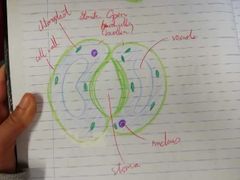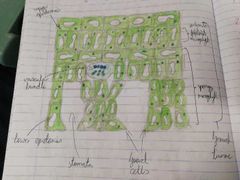![]()
![]()
![]()
Use LEFT and RIGHT arrow keys to navigate between flashcards;
Use UP and DOWN arrow keys to flip the card;
H to show hint;
A reads text to speech;
39 Cards in this Set
- Front
- Back
|
Nutrition in Plants |
- Autotrophic - Water delivered to leaves from roots by xylem - Sugars transported away from leaves to plant by phloem - Water is needed for photosynthesis + to form cytoplasm in cells. Also helps keep cells turgid + for chemical reactions |
|
|
Water Uptake |
- Water from soil enters plants through root hairs by osmosis - Occurs due to high water concentration in soil + low water concentration in cytoplasm of plant cells |
|
|
Adaptation of Roots for Water Uptake |
- Large no. Of root hairs which increases surface area for absorption - Root hairs have thin cell walls - Root hairs do not have a cuticle which allows water to pass through |
|
|
Water Transport |
- Water diffuses across the ground tissue into the xylem - Water travels up xylem, into stem + out into leaves. Xylem has pits which allow water to pass through |
|
|
Adaptations of Xylem for Transport |
- Thin, hollow continuous tubes - Strengthened walls with lignin - Pits allow sideways movement of water - Water moves up against gravity by: 1. Root Pressure 2. Transpiration |
|
|
Root Pressure |
Force that pushes water up stem from root [Water enters roots by osmosis which creates a pressure inside roots] [Root pressure pushes water up to top of plant through xylem. However, this pressure alone is not enough to meet leaves. Water is pulled to top by transpiration] |
|
|
Transpiration |
Loss of water vapour from surface of plant [When water evaporates from plant ground tissue, cells become less turgid. This causes water to move through xylem by osmosis. Through this, water molecules are pulled up the stem + roots] |
|
|
Percentage of water lost through evaporation through the stomata of leaves as water vapour |
99% |
|
|
Disadvantages of Transpiration |
Loss of water each day. If plants don't replace water = wilt + die. Dry conditions = plants find it difficult to Absorb water from soil |
|
|
To prevent wilting, plants reduce transpiration by: |
- Plant leaves have a wary cuticle to prevent water loss - Stomata are located on underside of leaf as more water is lost from upper surface - Stomata controlled by guard cells which change shape. Stomata open in day time for photosynthesis + close at night to retain water. However, environment can cause stomata to close during day. |
|

1. |

|
|

2. |

|
|

|

Transection of a Leaf: Gas Exchange |
|

|

Modified Root: Carrot - Tap root swollen with stored food - Root harvested before flowers produced |
|

|

Modified Leaf: Onion - Bulb produced containing small underground stem - Swollen, fleshy leaves attach to stem to store food - Leaves surround central apical bud with lateral/axillary buds at reduced stem |
|

|

Modified Stem: Potato (tuber) - Underground stem system. Tips of stem swell with starch - Axillary buds > "eye" of potato |
|
|
Who created the Cohesion-Tension Model? |
Henry Dixon + John Joly (Trinity College) |
|
|
Definition of Cohesion-Tension Model |
How water travels against gravity |
|
|
Cohesion |
Sticking of water molecules to each other |
|
|
Adhesion |
Sticking of water molecules to xylem walls |
|
|
Cohesion-Tension Model |
1. Transpiration: - Daylight, stomata open - Water evaporates from xylem cells, move into leaf cells by osmosis 2. Cohesion: Each water molecule pulls next water molecule along 3. Tension: - Continuous chain of water in xylem creates tension felt all over plant incl. Roots due to cohesion of water - Water molecules stick to each other + to xylem walls by adhesion 4. - Tension causes xylem to narrow as it stretches - Tension great enough to pull water 150m upwards - Transpiration Steam: Flow of water upwards 5. When transpiration stops (at night), lack of tension allows xylem to widen to normal shape - Xylem doesn't collapse under tension as it is reinforced with lignin |
|
|
Gas Exchange in Leaf |
Stomata on underside of leaves open + close to allow carbon dioxide into leaf air space + allow oxygen + water out of air space into atmosphere. Occurs due to diffusion. |
|
|
Gas Exchange in Stem |
Stems have lenticels (openings in bark of plants) allow for gas exchange. Oxygen enters lenticels whereas carbon dioxide + water released. |
|
|
Function of Guard Cells |
Control stomata by changing shape |
|
|
What controls guard cells |
Carbon Dioxide concentration in leaf air space |
|
|
Photosynthesis at Night |
- Rate falls - Carbon dioxide builds up in air spaces as not used - Guard cells have little water > shrivel - Stomata close |
|
|
Why are celery + rhubarb not modified leaves? |
Are leaf petioles |
|
|
Photosynthesis at Day |
- Rate increases - Carbon dioxide absorbed + used by mesophyll cells > Carbon dioxide concentration in air space low - Guard cells fill with water + become turgid - Stomata open |
|
|
Ways guard cells can be controlled |
- Potassium ions - Internal guard cell clock - Heat > increase transpiration > water level drop > stomata close |
|
|
Minerals that enter root hair |
Dissolved minerals (calcium + magnesium), nitrates, potassium ions + phosphates |
|
|
Minerals enter root hair by... |
Diffusion |
|
|
Minerals move through plant by... |
Active transport: movement of molecules against concentration gradient that requires energy |
|
|
What supplies plant energy for active transport? |
Mitochondria in root hair cells |
|
|
What transports minerals + water around plant? |
Xylem |
|
|
Where does photosynthesis take place in leaf? |
Mesophyll cells (ground tissue) |
|
|
Sources of Carbon Dioxide |
- Diffuses from atmosphere - Plant respiration |
|
|
Fate of Oxygen afte Photosynthesis |
Produced by leaves + released into atmosphere by diffusion |
|
|
Fate of Glucose after Photosynthesis |
- Used in respiration - Converted to starch + stored in spongy mesophyll - Converted to sucrose + moved through phloem as sap. Then transported around plant for energy/storage/growth |
|
|
Modified organs |
Foods that have been altered in order to store more food |

